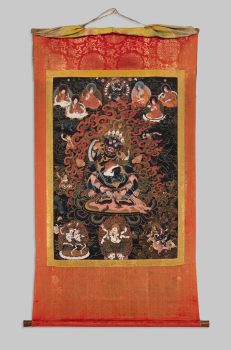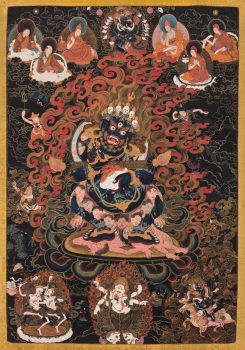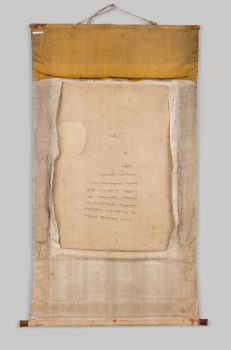Central Tibet
early 18th century, ca. 1720
A skull cup is an attribute of tantric deities and is usually paired with a curved knife. It can symbolize a mind filled with the bliss of realizing the true nature of reality.
Central Tibet
early 18th century, ca. 1720



Mahakala is the main protector of the Sakya tradition and a guardian deity in one of the main tantric practices, called the Hevajra Tantra. This form—Panjarnata, or “Great Black Lord of the Tent”—has a corpulent body and a large head with a menacing countenance. He holds his main attribute, a wooden staff, balancing it on his forearms. He wears a crown of skulls and a garland of severed heads. The black background of the painting was made using ashes from a funeral pyre mixed with the pigment. This method is said to have been created by faithful students who used the ashes of their late teacher in paintings depicting the deities of the practices they were taught by their teacher.
A religious movement that originated in India around the fifth to seventh century with sacred writings and esoteric teachings and practices transmitted from teacher to student through initiation. These remain an important part of Hinduism and Buddhism today.
A virtuous feeling and deep respect toward an authentic teaching, teacher, or path. Buddhists believe that expansive study, analysis, and meditation are essential steps for cultivating a healthy and enduring devotion.
Buddhist practitioners in some traditions believe that cutting through ordinary perceptions that keep us in the endless cycle of death and rebirth, known as samsara, can create a powerful and enhanced divine identity that leads to enlightenment.
A meditation technique primarily used in tantric practice that involves imagining a deity in one’s mind or imagining oneself becoming a deity and carrying out various activities. Such techniques are intended to help a practitioner transform ordinary perception and achieve enlightened qualities.
Protectors of Buddhist teachings who destroy obstacles that impede the path to enlightenment. The more frightening and gruesome their appearance, the greater their power.
Today, Tibetans primarily inhabit the Tibetan Plateau, situated between the Himalayan mountain range and the Indian subcontinent to the west, Chinese cultural regions to the east, and Mongolian cultural regions to the northeast. During the 7th to 9th century, Tibetan rulers expanded their empire across Central Asia, and established Buddhism as the state religion.
Get the latest news and stories from the Rubin, plus occasional information on how to support our work.